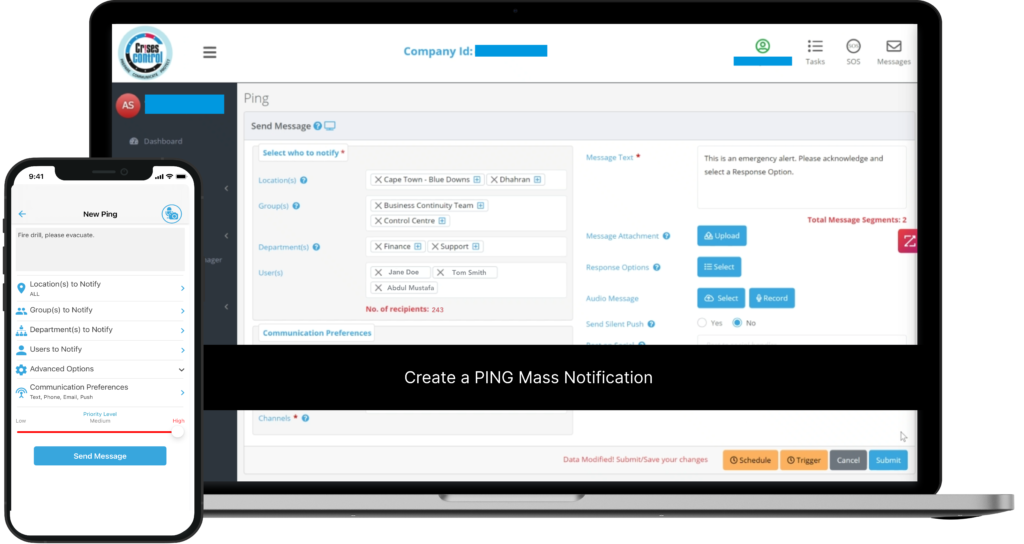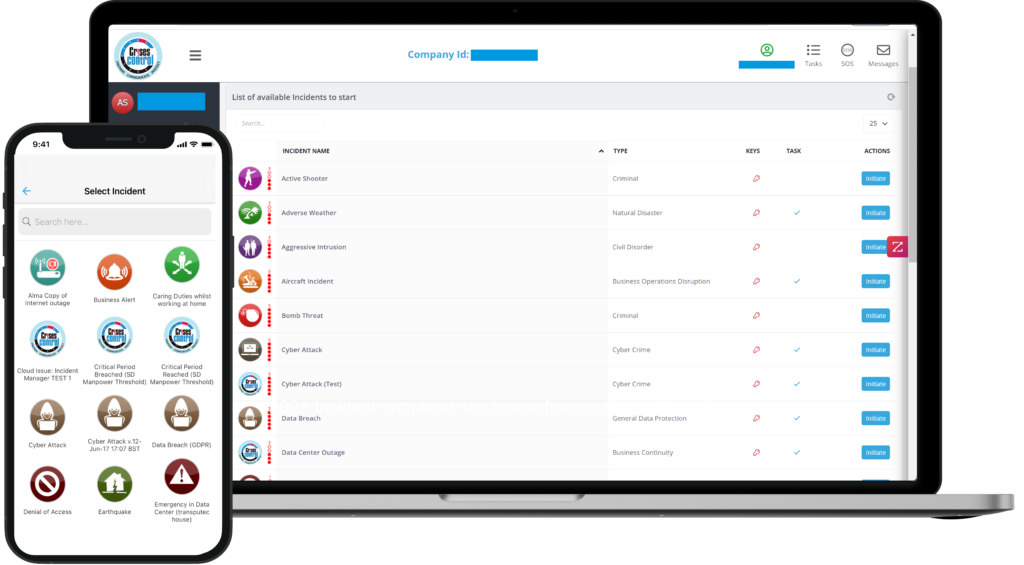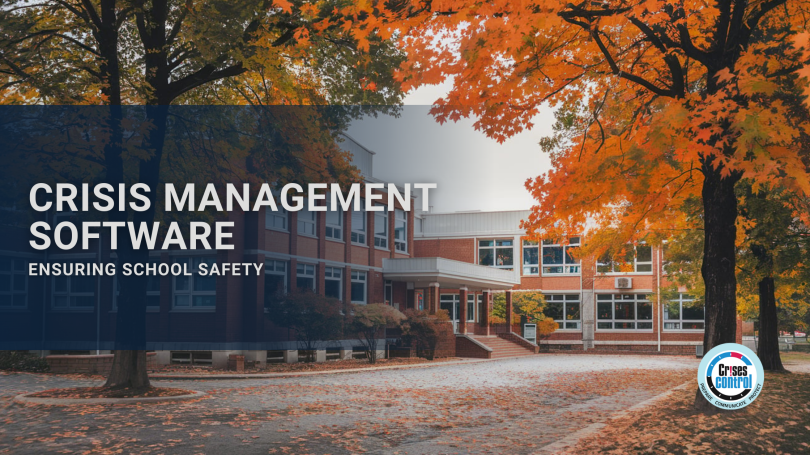Written by Anneri Fourie | Marketing Executive
In an era where the safety and well-being of students and staff are constantly threatened by new and evolving risks, schools must go beyond the traditional emergency plans of the past. While fire drills and basic safety protocols have long been the cornerstone of school preparedness, today’s schools face more complex challenges, such as active shooter incidents, cybersecurity breaches, and natural disasters. These require a more sophisticated and dynamic approach to crisis management.
Enter crisis management software, a solution designed to modernise school safety protocols and ensure preparedness for any type of emergency. In this blog, we’ll explore how adopting crisis management software tailored for schools can help institutions move beyond outdated safety methods. We’ll also highlight how Crises Control, a robust incident and crisis management platform, can enhance school safety and adapt strategies to address the modern threat landscape.
Why Traditional School Safety Methods Fall Short
For decades, schools have relied on routine drills—such as fire, earthquake, and tornado drills—as their primary method for preparing for emergencies. While these drills address predictable situations, they are not enough for the increasing complexity of today’s threats.
1. Inadequate Response to Active Threats
Fire drills follow a simple, rehearsed procedure: students line up, exit the building, and gather in designated areas. But modern threats—such as active shooters—require flexible, immediate responses. These types of emergencies need dynamic action plans, such as lockdown procedures or evacuation routes based on real-time information. Schools need a system that can help guide them through this unpredictability and not rely solely on one-size-fits-all plans.
2. Delayed Communication During Emergencies
In a crisis, every second matters. Traditional methods of informing staff and students, such as using the intercom system or word-of-mouth, are often slow and inefficient. When time is of the essence, schools need to communicate with staff, students, parents, and even first responders in real time. Delayed communication can lead to confusion, missed steps, or worse, preventable injuries.
3. Lack of Real-Time Incident Management
Once an emergency starts, schools often lack the tools needed for real-time incident tracking and coordination. Without a system in place to monitor the situation, manage evolving threats, and communicate with law enforcement or emergency responders, the response can become chaotic. Imagine managing a lockdown or evacuation without knowing exactly where your students or staff are located, or how the crisis is unfolding—such gaps in information can lead to dangerous missteps.
How Crisis Management Software Modernises School Safety
Crisis management software offers schools a new way to handle emergencies—one that is structured, responsive, and adaptable to different situations. Let’s dive into some of the key features that make this software an essential tool for schools.
1. Instant Mass Notifications
One of the most valuable aspects of crisis management software is its ability to send mass notifications instantly. When a crisis occurs, school administrators can immediately broadcast alerts to staff, students, and parents across multiple channels—text, email, mobile push notifications, and even voice calls. This ensures that everyone, including first responders, is informed in real time, allowing them to act quickly.
For example, in the event of a lockdown due to an active shooter on campus, an immediate alert can be sent to everyone on school grounds, as well as law enforcement, ensuring the fastest possible response. Compare this to the time it takes to make a traditional announcement over the intercom, and the difference could be life-saving.
2. Real-Time Incident Management
Crisis management software doesn’t just notify—it also helps schools manage crises as they unfold. Through real-time tracking, administrators can monitor the progression of a crisis, update safety protocols as necessary, and assign tasks to staff in real time.
Imagine a natural disaster, such as a flood or earthquake. The software allows school officials to:
Monitor the severity of the situation and threat levels.
Ensure each classroom is secure or evacuated as needed.
Coordinate with emergency services quickly and efficiently.
This real-time incident management feature reduces confusion and ensures that everyone involved in the response effort knows their role and responsibilities, keeping the process organised during a stressful time.
3. Customisable Emergency Plans
Schools are not one-size-fits-all, and neither are their safety needs. Crisis management software allows schools to create customised emergency plans that fit their specific needs, whether it’s a small private school or a large urban institution.
For example, a large high school might create separate protocols for different types of emergencies, like fire drills, active shooter lockdowns, or extreme weather events. Each plan can be tailored to the layout of the campus, the number of students, and the role of staff in different situations. Schools can also include automated instructions and checklists to ensure everyone follows the correct steps during an emergency.
Customisable plans also accommodate modern concerns, such as cybersecurity threats. In the event of a data breach or cyberattack, the software can guide the school through the appropriate actions to protect sensitive data and maintain operational continuity.
4. Reporting and Compliance
Compliance with local, state, and federal safety regulations is a critical concern for schools. Crisis management software simplifies the process of documenting safety drills and real emergencies by generating detailed reports that track metrics such as response times, task completion, and student and staff accountability.
These reports are essential for audits, safety reviews, and meeting legal obligations. By automating the reporting process, schools can focus more on keeping students safe and less on administrative paperwork.
Crises Control: A Comprehensive Crisis Management Solution for Schools
When it comes to school safety, Crises Control stands out as a reliable and comprehensive solution that addresses every aspect of incident and crisis management. Here’s how Crises Control can transform school safety:
1. Mass Notification System
Crises Control’s Ping mass notification system allows schools to instantly communicate important information to everyone on campus and beyond. With multi-channel alerts—including SMS, email, and push notifications—no one is left in the dark during an emergency.
For instance, if a fire breaks out, Crises Control can notify all staff, students, and first responders within seconds, expediting the evacuation process and potentially saving lives.
2. Real-Time Incident Management
The Crises Control Incident Manager enables schools to track ongoing emergencies in real time. Administrators can assign tasks, monitor the situation, and ensure that every step of the emergency plan is followed.
During a lockdown, for example, school leaders can use Crises Control to monitor which classrooms are secure, communicate with local authorities, and make real-time adjustments to the safety protocol based on the evolving situation.
3. Task Manager
Crises Control’s Task Manager feature allows administrators to assign specific roles to staff during an emergency, ensuring that every critical step is accounted for. From securing doors to checking student roll-call, the software keeps everyone on the same page.
4. SOS Panic Button
For immediate, life-threatening situations, Crises Control’s SOS Panic Button allows staff to send distress signals directly to emergency services and school leaders. This feature is vital in active shooter situations or when there’s an immediate danger to student safety.
5. Automated Reporting and Compliance
Once the emergency is over, Crises Control automatically generates comprehensive reports detailing every aspect of the response. These reports are critical for meeting regulatory compliance and help schools continually improve their safety plans.
Interested in our Ping Mass Notification Software?
Efficiently alert everyone in seconds at scale with our Mass Notification System – PING, get the message out fast and ensure rapid response and recovery.

Benefits of Using Crisis Management Software for Schools
Adopting crisis management software, like Crises Control, brings numerous benefits to schools:
- Increased Safety: Faster communication and better coordination help protect students and staff during any emergency.
- Reduced Response Time: Instant notifications and real-time tracking significantly cut down the time it takes to respond.
- Improved Coordination: Customisable emergency plans and task management ensure a smooth, organised response.
- Simplified Compliance: Automated reporting makes it easier for schools to meet their safety and regulatory obligations.
- Peace of Mind for Parents: Real-time communication with parents during a crisis helps reduce panic and confusion.

Interested in our Incident Management Software?
Customise your Crisis Incident Management Software to meet your specific needs with our flexible tools & stay connected and informed during the crisis and incident management process
Conclusion: Stay Ahead of Emerging Threats with Crises Control
Today’s schools need to be prepared for a wide variety of threats, from routine fire drills to complex emergencies like active shooter incidents. Crisis management software is essential for schools to stay ahead of these challenges, ensuring the safety of students, staff, and the entire school community.
Crises Control offers all the tools schools need to modernise their emergency protocols, reducing response times, improving communication, and ensuring compliance with safety regulations. Don’t wait for a crisis to happen—take the next step in protecting your school today.
Contact us for a free demo of Crises Control and upgrade your school’s safety measures.
Request a FREE Demo

